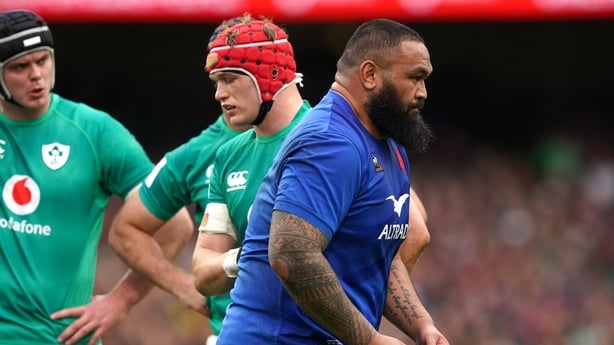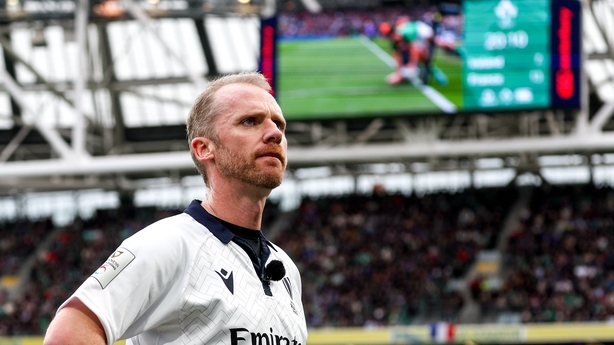Week Two of the Six Nations was dominated by the quality of rugby on display in the Ireland-France match at the Aviva Stadium on Saturday.
Yet, there are dark undertones around the safety of the game following a forceful high tackle by Uini Atonio on Rob Herring, who retired from the game following a HIA a couple of phases later.
Rugby, as a game, is going to be scrutinised, analysed, celebrated and championed in this World Cup year. However, if we don't create a robust framework that allows the players to be safe, the celebrations and positive analysis will be drowned out by sombre moments of collisions and contacts.
Wayne Barnes is a very competent referee, highly regarded and arguably one of the best in the world. He has a background in law and methodically follows the legal framework whenever there are foul play incidents in the game.
However, he got the Uini Atonio tackle on Rob Herring horribly wrong. I have a bit of sympathy for Barnes. In the heat of the moment, in one of the most exciting test matches in a few years, he tried to use the framework bestowed onto him by World Rugby.
World Rugby have somehow structured the high contact and foul play framework in such a way that they want their referees to look for mitigation in the case of a disastrous tackle.
Barnes used this framework to talk the tackle down from a red card offence to a yellow, hinging on the assumption that there was a low degree of danger in the tackle. This is where he went wrong but he had to follow his judgement through to come to a yellow card sanction.
One factor in the judgement of a high degree of danger is where the initial contact was made. This is fine when the framework helps to save a genuine attempt at a lower tackle and there has been some movement from the opposition player, or some event has happened in leading up to that tackle, where there should be a benefit of the doubt given to a tackle.
In clearer examples, you can see where the contact may have been made on the shoulder or chest of a player and the force ends up going through the ball carrier's head in a secondary action.

Uini Atonio’s tackle was not one of those moments. Barnes identified from the slow motion replay that there was a glancing contact on Rob Herring’s body somewhere below the head, and this caused his head to go forward and collide with the tackling shoulder of Atonio. This was completely misjudged by the referee.
Atonio’s shoulder brushed off the body of Herring and was always heading towards a brain injury for the Irish hooker.
However, in defence of Atonio, he shouldn’t be treated any differently to another player that has made this tackle. The fact that he is north of 140kg shouldn’t come into the conversation when determining the degree of danger. His actions within the tackle should be judged and not his body weight.
Yes, we determine body height and sometimes mitigate when a very tall player at least tries to drop their height when tackling a smaller player. However, you can’t calculate the degree of force from one large body making a hit to another slightly less large body making a similar hit. That is not our decision to make.
The degree of danger should be calculated solely on the tacklers actions. He stood completely upright and made no attempt to drop his body height, meaning that the likelihood of hitting Herring’s head was quite high.
Atonio didn’t attempt a passive tackle either, he stepped forward to make a dominant tackle on Herring, seeking contact through his own forward motion, another determining factor in the degree of danger involved in the tackle.
Not only that but he failed to wrap his tackling arm in the contact area, making this an even bigger act of foul play.
None of these determining factors should have worked in favour of the tackling player, who has sole responsibility for the person that they are tackling.
This is similar to when players get taken out in the air without any intent from the player committing the foul. Intent isn’t what we are looking for. The tackler, or the opposition jumper in the case of a high ball, has sole responsibility for the person that they are competing with.
A measly citing and brushing yet another poor decision under the bumpy carpet of World Rugby isn't going to cut it.
I would implore anyone to stand on the other side of that tackle and tell me that there wasn’t a high degree of danger. Could Wayne Barnes stand there and back up his judgement of a 'low degree of danger involved'?
This was a test match for the ages, and unfortunately for some of us it has been marred by a refereeing decision influenced by a framework that is becoming increasingly frustrating and not fit for purpose.

This isn’t about putting Wayne Barnes on trial, you could put a blank face on the referee from the weekend and I would have the same reaction because I have no ill-feeling towards Barnes as a referee. In fact, I think he is one of the best with his calm and rational decisions and his bilingual skills.
However, someone, somewhere has to be accountable for these decisions on a weekly basis. Can World Rugby come out and back their referee in this instance? Can Wayne Barnes stand over his decision without the pressure of the electric atmosphere and the responsibility for not scuppering the most eagerly anticipated test matches in a few tournaments?
If they can, or he does, a lot of stakeholders will be lost within the game. Ex-players, journalists, pundits, the casual supporter, most rational observers have disagreed with this decision. Indeed, anyone that’s not trying too hard to sound tough would disagree with the decision.
What is it going to take to make rugby take the high contact nature of its own game seriously?
A measly citing and brushing yet another poor decision under the bumpy carpet of World Rugby isn’t going to cut it.
I want to see a statement from someone either agreeing or disagreeing with the decision. Stand by the tackle and lose the sane and rational followers of a slowly changing game.
Or disagree publicly with the framework that set the decision up and show that the player safety is the only important thing in the mind of World Rugby right now.
Anything less will show us that players are just part of a product - and considered as people second.





